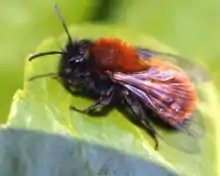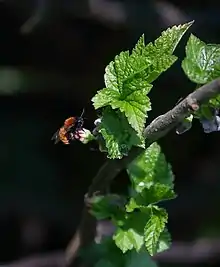Tawny mining bee
The tawny mining bee, Andrena fulva, is a European species of the sand bee (Andrena) genus. The males are 10–12 mm (0.4–0.5 in) and the females 8–10 mm (0.3–0.4 in) long. The female is covered with fox-red hair on the dorsal surface of its thorax and abdomen and black hair on its head and ventral surface. The male is less distinctive, being clad in golden-brown or reddish-brown hairs, with some long white hairs on the face, and a tooth on each of the mandibles.[1]
| Tawny mining bee | |
|---|---|
 | |
| Scientific classification | |
| Kingdom: | Animalia |
| Phylum: | Arthropoda |
| Class: | Insecta |
| Order: | Hymenoptera |
| Family: | Andrenidae |
| Genus: | Andrena |
| Species: | A. fulva |
| Binomial name | |
| Andrena fulva Müller, 1766 | |
The tawny mining bee lives in Europe, ranging from the Balkans to southern Scandinavia, the United Kingdom and Ireland.[2] It lives among short vegetation in light woodlands and dry grasslands, and also in parks and gardens. It is widely distributed but has a low population density. It is present in lowland England and Wales and at a few sites in southern Scotland. In Ireland it is known only from County Kilkenny, and may be regionally extinct there.[1]
The tawny mining bee flies from March until May. It prefers to fly to a range of different nectar-producing and pollen-bearing plants; these include beech (Fagus sylvatica), blackthorn (Prunus spinosa), buttercup (Ranunculus sp.), garlic mustard (Alliaria petiolata), gooseberry (Ribes uva-crispa), hawthorn (Crataegus monogyna), holly (Ilex aquifolium), maple (Acer sp.), oak (Quercus sp.), plum (Prunus domestica), sallow (Salix sp.), sycamore (Acer pseudoplatanus) and wayfaring-tree (Viburnum lantana).[1]

It mates in spring, after which the male dies and the female starts to build a nest. Sometimes more than a hundred females build nests in a few square metres but the tawny mining bee normally does not create a colony, each female having her own nest. The tawny mining bee is therefore classified amongst solitary and communal bees. The nest is a vertical shaft 200–300 mm (8–12 in) deep, with several brood cells branching off it. The female fills these cells with a mixture of nectar and pollen, on which she lays one egg in each cell. The larva hatches within a few days, grows quickly and pupates within a few weeks. The adults emerge in spring after hibernation.[1]

References
- "Andrena fulva (Müller, 1766)". Bees, Wasps and Ants Recording Society.
- Shevaun Doherty Botanical Artist; paying tribute to the hardest working insects on the planet. AV Media. 16 July 2018. Retrieved 17 July 2018.